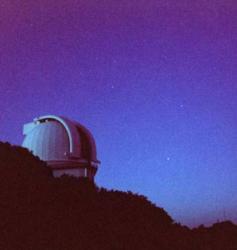 Buying your first telescope can be a nerve-wracking experience filled with buyer’s remorse. This week we discuss the basics of purchasing your first binoculars and telescope. What to look for, how to clean older equipment, and how to use it for the first time. Let’s make sure your first investment in this wonderful hobby is money well-spent.
Buying your first telescope can be a nerve-wracking experience filled with buyer’s remorse. This week we discuss the basics of purchasing your first binoculars and telescope. What to look for, how to clean older equipment, and how to use it for the first time. Let’s make sure your first investment in this wonderful hobby is money well-spent.
Continue reading “Podcast: Choosing and Using a Telescope”
Matter Should Dominate the Universe Forever
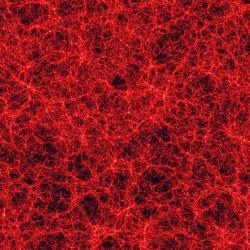 Thanks to Einstein, we know that matter and energy are just different versions of one another. E=mc2 tells you how much energy you’d get if you converted mass into energy. Don’t try, it’s hard. Physicists were concerned that all matter in the Universe would eventually decay into radiation after trillions and trillions of years of time.
Thanks to Einstein, we know that matter and energy are just different versions of one another. E=mc2 tells you how much energy you’d get if you converted mass into energy. Don’t try, it’s hard. Physicists were concerned that all matter in the Universe would eventually decay into radiation after trillions and trillions of years of time.
Continue reading “Matter Should Dominate the Universe Forever”
Earth-Sized Planet Discovered in the Habitable Zone
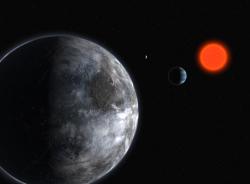 Great big Jupiter-like planets are one thing, but the Holy Grail of extrasolar planetary discover is going to be another Earth – complete with life. We’re not there yet, but astronomers announced the next best thing yesterday: a roughly Earth-mass planet orbiting within the habitable zone of its parent star. In other words, liquid water could exist on this rocky planet.
Great big Jupiter-like planets are one thing, but the Holy Grail of extrasolar planetary discover is going to be another Earth – complete with life. We’re not there yet, but astronomers announced the next best thing yesterday: a roughly Earth-mass planet orbiting within the habitable zone of its parent star. In other words, liquid water could exist on this rocky planet.
Continue reading “Earth-Sized Planet Discovered in the Habitable Zone”
What’s Up this Week: April 23 – April 29, 2007
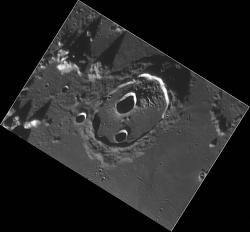 Monday, April 23 – Pioneer quantum physicist Max Planck was born on this day in 1858. In 1900, Max developed the Planck equation to explain the shape of blackbody spectra (a function of temperature and wavelength of emission). A “blackbody” is any object that absorbs all incident radiation – regardless of wavelength. For example, heated metal has blackbody properties because the energy it radiates is thermal. The blackbody spectrum’s shape remains constant, and the peak and height of an emitter can be measured against it – be it cosmic background radiation or our own bodies.
Monday, April 23 – Pioneer quantum physicist Max Planck was born on this day in 1858. In 1900, Max developed the Planck equation to explain the shape of blackbody spectra (a function of temperature and wavelength of emission). A “blackbody” is any object that absorbs all incident radiation – regardless of wavelength. For example, heated metal has blackbody properties because the energy it radiates is thermal. The blackbody spectrum’s shape remains constant, and the peak and height of an emitter can be measured against it – be it cosmic background radiation or our own bodies.
Continue reading “What’s Up this Week: April 23 – April 29, 2007”
Book Review: Brave New Universe
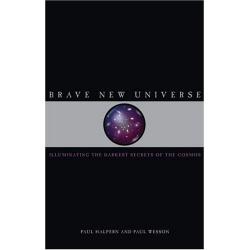 A steady progression of space borne and Earth-based telescopes bring long ago, far away events into our common perspective. We take these images, massage and arrange the hard won data, and, develop new interpretations of our existence and surroundings. Paul Halpern and Paul Wesson in their book Brave New Universe – Illuminating the Darkest Secrets of the Cosmos lay bare recent theories and postulations resulting from this. As they show, new information, when added to the mix, can as easily validate as confuse current prognoses.
A steady progression of space borne and Earth-based telescopes bring long ago, far away events into our common perspective. We take these images, massage and arrange the hard won data, and, develop new interpretations of our existence and surroundings. Paul Halpern and Paul Wesson in their book Brave New Universe – Illuminating the Darkest Secrets of the Cosmos lay bare recent theories and postulations resulting from this. As they show, new information, when added to the mix, can as easily validate as confuse current prognoses.
Continue reading “Book Review: Brave New Universe”
See the Sun, In Thrilling 3-D!
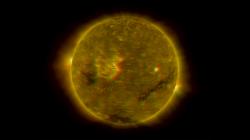 NASA’s newest solar observatories have released their first images of the Sun, and they’re great. Of course, to really enjoy the pictures, you’ll need 3-D glasses.
NASA’s newest solar observatories have released their first images of the Sun, and they’re great. Of course, to really enjoy the pictures, you’ll need 3-D glasses.
Continue reading “See the Sun, In Thrilling 3-D!”
Expedition 14 Returns to Earth
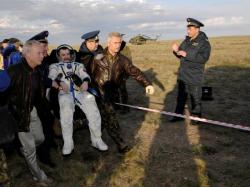 The two crewmembers of Expedition 14 returned to Earth on Saturday, with astro-tourist Charles Simonyi along for the ride. Commander Mike Lopez-Alegria and Flight Engineer Mikhail Tyurin had been aboard the International Space Station since September 20th, while Simonyi arrived on April 7th. Their Soyuz TMA-9 capsule touched down in the Central Asian steppes of Kazakhstan at 1231 GMT (8:31 am EDT).
The two crewmembers of Expedition 14 returned to Earth on Saturday, with astro-tourist Charles Simonyi along for the ride. Commander Mike Lopez-Alegria and Flight Engineer Mikhail Tyurin had been aboard the International Space Station since September 20th, while Simonyi arrived on April 7th. Their Soyuz TMA-9 capsule touched down in the Central Asian steppes of Kazakhstan at 1231 GMT (8:31 am EDT).
Continue reading “Expedition 14 Returns to Earth”
Hubble’s Detailed Photograph of the Carina Nebula
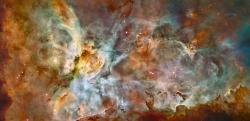 It’s hard to believe, but the Hubble Space Telescope has been churning out discovery after discovery for 17 years now. To celebrate the anniversary, NASA and ESA released a high-resolution image taken by Hubble of the Carina Nebula. And what a photograph!
It’s hard to believe, but the Hubble Space Telescope has been churning out discovery after discovery for 17 years now. To celebrate the anniversary, NASA and ESA released a high-resolution image taken by Hubble of the Carina Nebula. And what a photograph!
Continue reading “Hubble’s Detailed Photograph of the Carina Nebula”
Black Holes Could Provide the Seeds of Life
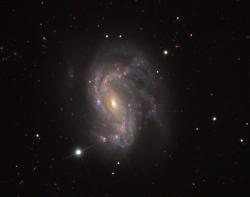 You’ve heard it all before. Black holes pull with a gravity so strong that nothing, not even light, can escape. You would think that black holes are the place where everything goes to die, but it might be possible that black holes are the source of life as well.
You’ve heard it all before. Black holes pull with a gravity so strong that nothing, not even light, can escape. You would think that black holes are the place where everything goes to die, but it might be possible that black holes are the source of life as well.
Continue reading “Black Holes Could Provide the Seeds of Life”
Podcast: The Search for Neutrinos
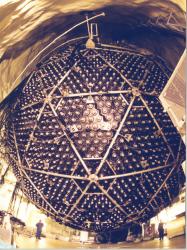 Trillions of neutrinos are produced in our Sun through its nuclear reactions. These particles stream out at nearly the speed of light, and pass right through any matter they encounter. In fact, there are billions of them passing through your body right now. Learn how this elusive particle was first theorized and finally discovered.
Trillions of neutrinos are produced in our Sun through its nuclear reactions. These particles stream out at nearly the speed of light, and pass right through any matter they encounter. In fact, there are billions of them passing through your body right now. Learn how this elusive particle was first theorized and finally discovered.
Continue reading “Podcast: The Search for Neutrinos”
